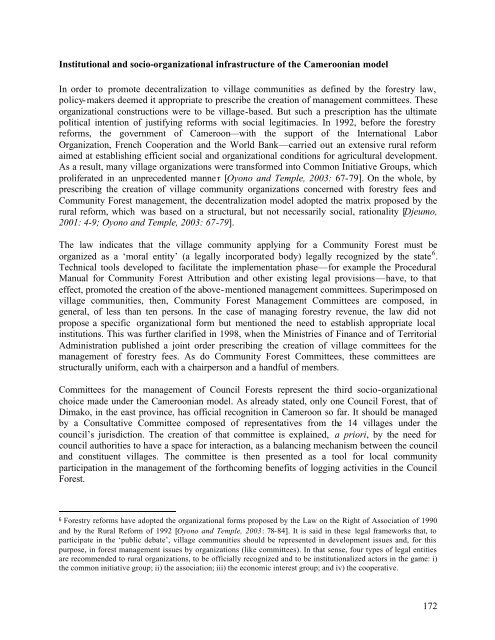chapter 10 social and organizational roots of ecological ...
chapter 10 social and organizational roots of ecological ...
chapter 10 social and organizational roots of ecological ...
Create successful ePaper yourself
Turn your PDF publications into a flip-book with our unique Google optimized e-Paper software.
Institutional <strong>and</strong> socio-<strong>organizational</strong> infrastructure <strong>of</strong> the Cameroonian modelIn order to promote decentralization to village communities as defined by the forestry law,policy-makers deemed it appropriate to prescribe the creation <strong>of</strong> management committees. These<strong>organizational</strong> constructions were to be village-based. But such a prescription has the ultimatepolitical intention <strong>of</strong> justifying reforms with <strong>social</strong> legitimacies. In 1992, before the forestryreforms, the government <strong>of</strong> Cameroon—with the support <strong>of</strong> the International LaborOrganization, French Cooperation <strong>and</strong> the World Bank—carried out an extensive rural reformaimed at establishing efficient <strong>social</strong> <strong>and</strong> <strong>organizational</strong> conditions for agricultural development.As a result, many village organizations were transformed into Common Initiative Groups, whichproliferated in an unprecedented manner [Oyono <strong>and</strong> Temple, 2003: 67-79]. On the whole, byprescribing the creation <strong>of</strong> village community organizations concerned with forestry fees <strong>and</strong>Community Forest management, the decentralization model adopted the matrix proposed by therural reform, which was based on a structural, but not necessarily <strong>social</strong>, rationality [Djeumo,2001: 4-9; Oyono <strong>and</strong> Temple, 2003: 67-79].The law indicates that the village community applying for a Community Forest must beorganized as a ‘moral entity’ (a legally incorporated body) legally recognized by the state 6 .Technical tools developed to facilitate the implementation phase—for example the ProceduralManual for Community Forest Attribution <strong>and</strong> other existing legal provisions—have, to thateffect, promoted the creation <strong>of</strong> the above-mentioned management committees. Superimposed onvillage communities, then, Community Forest Management Committees are composed, ingeneral, <strong>of</strong> less than ten persons. In the case <strong>of</strong> managing forestry revenue, the law did notpropose a specific <strong>organizational</strong> form but mentioned the need to establish appropriate localinstitutions. This was further clarified in 1998, when the Ministries <strong>of</strong> Finance <strong>and</strong> <strong>of</strong> TerritorialAdministration published a joint order prescribing the creation <strong>of</strong> village committees for themanagement <strong>of</strong> forestry fees. As do Community Forest Committees, these committees arestructurally uniform, each with a chairperson <strong>and</strong> a h<strong>and</strong>ful <strong>of</strong> members.Committees for the management <strong>of</strong> Council Forests represent the third socio-<strong>organizational</strong>choice made under the Cameroonian model. As already stated, only one Council Forest, that <strong>of</strong>Dimako, in the east province, has <strong>of</strong>ficial recognition in Cameroon so far. It should be managedby a Consultative Committee composed <strong>of</strong> representatives from the 14 villages under thecouncil’s jurisdiction. The creation <strong>of</strong> that committee is explained, a priori, by the need forcouncil authorities to have a space for interaction, as a balancing mechanism between the council<strong>and</strong> constituent villages. The committee is then presented as a tool for local communityparticipation in the management <strong>of</strong> the forthcoming benefits <strong>of</strong> logging activities in the CouncilForest.6 Forestry reforms have adopted the <strong>organizational</strong> forms proposed by the Law on the Right <strong>of</strong> Association <strong>of</strong> 1990<strong>and</strong> by the Rural Reform <strong>of</strong> 1992 [Oyono <strong>and</strong> Temple, 2003: 78-84]. It is said in these legal frameworks that, toparticipate in the ‘public debate’, village communities should be represented in development issues <strong>and</strong>, for thispurpose, in forest management issues by organizations (like committees). In that sense, four types <strong>of</strong> legal entitiesare recommended to rural organizations, to be <strong>of</strong>ficially recognized <strong>and</strong> to be institutionalized actors in the game: i)the common initiative group; ii) the association; iii) the economic interest group; <strong>and</strong> iv) the cooperative.172
















